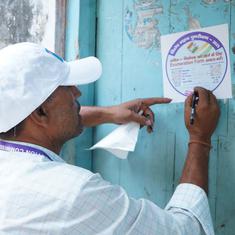The residents of West Bengal’s Mousini Island are all too familiar with damp, cracked walls and muddy floors littered with debris. It’s a sight that they, and those in the neighbouring islands of Sagar and Ghoramora, encounter regularly in their flood-ravaged homes. All around them, in the Sundarbans delta, climate change’s insidious footprints are visible: water levels are rising, their land is eroding, and livelihoods are getting lost.
Photographer Sushavan Nandy knew some of the struggles intimately. When he was a child, his riverside home in Jalpaiguri in Bengal would get flooded often during the monsoons. Losing your “your home is like losing a part of your identity,” he said. “I still clearly remember the floods and the time I spent in Jalpaiguri. Maybe that is why I feel a connection with the people on these islands.”
In 2016, Nandy began photographing the islands and documenting the lives of their people – some left behind by loved ones, some trying to rebuild their lives. The images make up the 33-year-old’s project Ebbing Away of Identity with the Tides.

The project captures the destruction wreaked by climate change through pictures of eroded coastlines and water pools created inland by high tidal waves. It reflects the hurt among a people whose lands are no longer suitable for farming because of rising salinity. The images contain untold stories of former farmers who have been forced to move to nearby towns to work as labourers, leaving their families behind.
“Many of [the women] had taken a boat ride to these islands [dreaming] of a happy married life,” said Nandy. “But [they] now live a lonely, sorrowful life as their husbands have left in order to earn money, and sometimes [have] even got married again.”
In one photograph, a woman clad in a faded sari, shoulders drooping, is staring at a stretch of barren land. In another, a woman is combing her hair. The melancholy in these portraits is heightened by the fact that none of the women – and even the men – wanted to face the camera while being photographed.

Researchers believe that the sea level in the Sundarbans delta region has risen annually by 3.14 cm since 1985, a rate significantly higher than the global average of 2 mm. A research paper titled Sea Level and associated changes in the Sundarbans states, “Over the last two decades crop and forest property worth Rs 950 million has been damaged or lost and over 0.4 million people have been affected, out of which around 600 families have had to migrate and settle elsewhere as environmental migrants due to storm surges and coastal flooding…The extent and intensity of coastal flooding is likely to increase in future over this part of the Sundarbans. The islands of Ghoramara, Dublat G.P. of Sagar Island, G-Plot and Mousuni are extremely vulnerable in this respect.”

In his conversations with the island dwellers, Nandy found that most do not even understand the concept of climate change. There is almost a resigned acceptance among them, according to him. “A 70-year-old man who has lived almost his whole life on Mousuni didn’t understand terms like sea level rising, and yet his life is an example of what such a phenomenon can do to you,” said Nandy. “People like him have lost their courtyard, where they have played, they have lost the trees from which they used to swing [as children]…even the land beneath their feet has been washed away.”
In one poignant image taken by Nandy, a man is standing on what looks like a rock jutting out of water. “On that piece of land, till a few months ago, stood his house,” said Nandy. “With the last tidal wave, his house and his life’s work were destroyed. It is not an easy feeling to see your home, your land, your place, which has witnessed generations of a family’s history, disappearing. It is like getting uprooted and having your legacy, your identity dissolved among waves and winds.”

All photographs by Sushavan Nandy.










